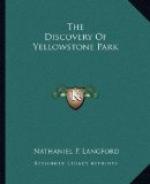All of these springs are embraced within a circle the radius of which is from a thousand to twelve hundred feet, and the whole of this surface seems to be a smothered crater covered over with an incrustation of sufficient strength and thickness to bear usually a very heavy weight, but which in several instances yielded and even broke through under the weight of our horses as we rode over it. We quickly dismounted, and as we were making some examinations, the crust broke through several times in some thin places through which vapor was issuing. Under the whole of this incrustation the hottest fires seem to be raging, and the heat issuing from the vents or from the crevices caused from the breaking in of the surface is too intense to be borne by the gloved hand for an instant. Surrounding the natural vents are deposits of pure sulphur, portions of which in many instances we broke off, and after allowing them to cool, brought them away with us. On the top of the mountain overlooking the large sulphur spring is a small living crater about six inches in diameter, out of which issue hot vapor and smoke. On the slope adjoining the mud spring is another crater of irregular shape, but embracing about one hundred square inches, out of which issues hot vapor, the rocks adjoining changing color under the intense heat with every breath blown upon them.
The tramp of our horses’ feet as we rode over the incrustation at the base of the mountain returned a hollow sound; yet while some of our party were not disposed to venture upon it with their horses, still I think with care in selecting a route there is very little danger in riding over it.
On the mountain, large quantities of sulphur formed by the condensation of the vapor issuing from the crevices, now closed, but once in activity in the incrusted covering, have been deposited, and we collected many specimens of pure and crystallized sulphur. Thousands of pounds of pure and nearly pure sulphur are now lying on the top and sides of the mountain, all of which can be easily gathered with the aid of a spade to detach it from the mountain side incrustations to which it adheres in the process of condensation. We gave to this mountain the name “Crater hill.”
Five miles further on we camped near the “Mud geyser.” Our course to-day has been for the greater part over a level valley, which was plainly visible from the top of Mount Washburn. The water of the river at this point is strongly impregnated with the mineral bases of the springs surrounding our camp, and that empty into the river above it.




